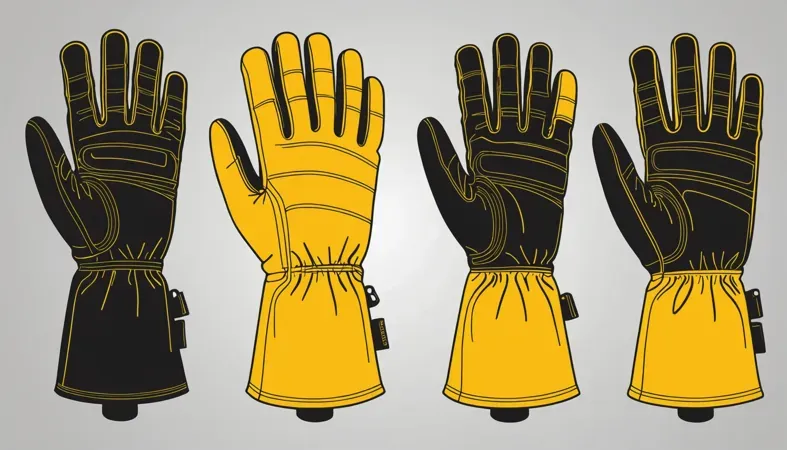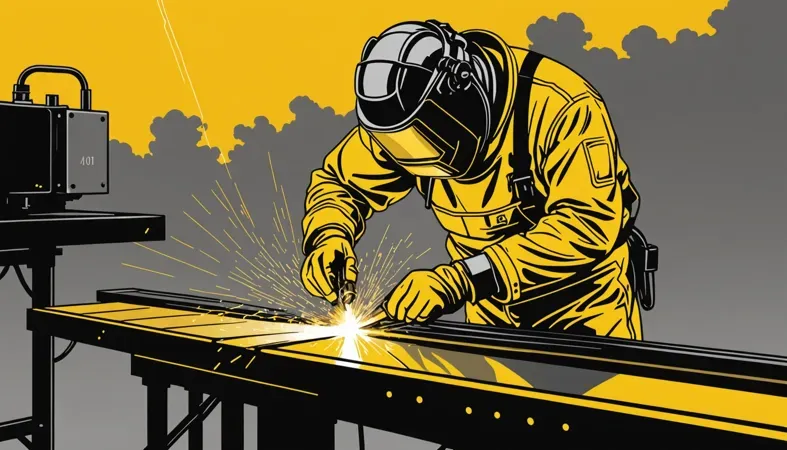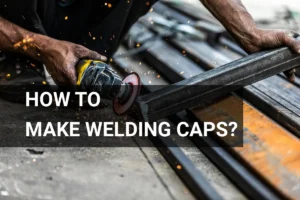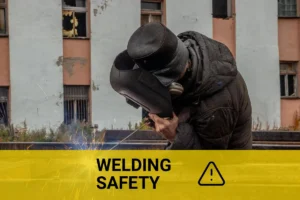What Are Welding Gloves Made Of? Materials, Types, and Selection Tips
Published on: April 16, 2025 | Last modified: March 4, 2025
By: Mark Carter
Welding gloves are protective gear worn while welding. They help safeguard your hands from heat, sparks, and sharp objects.
You may ask, what are welding gloves made of? Knowing the materials is crucial because the right gloves can make a big difference in your safety. I once used gloves that were too thin, and I learned the hard way how important quality is when it comes to staying protected.
In this guide, I’ll cover different materials used in welding gloves, how they function, types of gloves available, steps to choose the right pair, factors influencing glove materials, and FAQs. You’ll find out what type of gloves are used for welding, what are the best welding gloves, and even where you can buy welding gloves.
Contents
What Materials Are Used for Welding Gloves?
These gloves are typically made from leather, often cowhide or goatskin, and feature a heat-resistant lining. They’re used in welding to protect your hands from sparks, heat, and sharp objects. Ideal for both professional and hobbyist welders!

How Do Welding Gloves Work?
Welding gloves are mainly made from materials like leather, Kevlar, and sometimes rubber. These materials provide excellent heat resistance, often withstanding temperatures up to 260°C (500°F) or more. Leather offers durability and flexibility, while Kevlar adds strength and cuts protection. High-quality gloves can meet industry standards, like ASTM F2675, ensuring reliability in tough welding environments.
Gloves designed for MIG welding feature lighter materials for better dexterity, while those for stick welding often use thicker leather for extra protection. Understanding the materials in welding gloves helps you choose the right pair for your needs.
I once made the mistake of using thin gloves while working with high heat. The result? My hands suffered small burns! Always check the materials in your gloves; after all, the best welding gloves can prevent injuries and keep you safe on the job!
Types Of Welding Gloves
What types of gloves are available?
-
Leather Welding Gloves
Leather welding gloves are classic and durable. They’re made from cowhide or goatskin, known for strength and flexibility. Manufacturers typically select thick leather, cut patterns, and stitch them together, ensuring they cover your wrists for added protection. To fully utilize protective gear like these gloves, it’s crucial to learn the proper operation of a welding machine.
-
Kevlar Welding Gloves
Kevlar gloves offer excellent cut and heat resistance. They’re made from a lightweight, synthetic fiber that’s super strong. The fiber is woven into a thick, protective layer that can withstand high temperatures, making them ideal for TIG welding.
-
Aluminized Welding Gloves
Aluminized gloves are great for high-heat tasks. They have a reflective outer layer, often made of aluminum, that reflects heat. Manufacturers layer aluminum with a base material, like Kevlar or leather, providing heat resistance and durability.
-
Heat-resistant Welding Gloves
Heat-resistant gloves protect against extreme temperatures. They’re often made from specialized materials like Nomex or PBI. Manufacturers combine these high-temperature materials and reinforce key areas for extra safety without sacrificing comfort.
-
Insulated Welding Gloves
Insulated gloves keep you warm while you work. They’re often made with thick insulation layers, such as fleece or foam, sandwiched between durable outer materials. Manufacturers sew a strong shell around warm insulation, ensuring you stay comfortable in cold work environments.
So far we covered the different varieties of welding gloves. Next, let’s look at how to choose the right gloves.
Steps to Select the Right Welding Gloves
Now, we’ll cover the essential steps for choosing gloves for welding tasks.
-
Identify the Material
Examine different glove materials. Leather gloves are common for MIG and stick welding because they withstand temperatures up to 500°F (260°C). Kevlar offers extra cut protection, while rubber improves grip during precise tasks. Choose the material that best suits your welding process; it can make a significant difference. Knowing how to safely remove welds can also impact your material choices.
I’ve used leather gloves multiple times and found them durable. But for TIG welding, you might prefer gloves that offer more dexterity. Choose based on your specific welding needs.
-
Check the Thickness
Select the right glove thickness for your welding needs. Generally, 1/8 inch (3.2 Mm) thick gloves are robust enough for heavy welding, while thinner gloves at 1/16 inch (1.6 Mm) provide needed flexibility for lighter welds. Thicker doesn’t always mean better—functionality is key!
It is crucial to ensure that all welding projects comply with the industry’s safety and legal standards, especially when working on essential components like a car’s frame. Discover whether you can legally weld a car frame to maintain both performance and safety standards.
Thinner gloves help with precise movements, which I learned the hard way during delicate welding. A tester mindset can guide you to the best fit for your tasks. Don’t sacrifice comfort when considering thickness.
-
Verify the Heat Resistance
Welding gloves have varying heat resistance ratings. Standard gloves resist up to 500°F (260°C), but specialized gloves can withstand up to 1,000°F (540°C) for high-heat applications. Check manufacturer specifications to find what suits your work. Know the resistance limits to avoid burns.
I once made the mistake of using regular gloves for a high-heat application, and it wasn’t fun! Don’t risk your hands for a few extra dollars. Aim for gloves that match your welding style.
-
Assess Your Grip Needs
Your grip is crucial in welding. Look for gloves with textured palms for a better hold on tools. TIG welding may require more control, so choose gloves with enhanced grip features. Additional padding can balance heat protection and grip, but don’t overdo it; it can reduce finger sensitivity. It’s important to understand the materials and techniques because certain practices can lead to welding defects like porosity in welding.
I once tried gloves without much texture, and it was frustrating. Getting the grip right saves you from challenges and improves control. Take time to find gloves that cater to your grip and comfort level.
-
Consider the Length
Consider the length of the gloves. Longer gloves, like gauntlets, protect your wrists and forearms from sparks and spatter. Typically, gloves range from 14 inches (35 Cm) to 18 inches (46 Cm) long. Longer gloves provide better protection against direct contact and burns.
I learned this after getting burned on my wrist. Some jobs or angles make short gloves riskier, so don’t skimp on length. It’s worth paying attention to this detail.
That covers the steps for choosing appropriate welding gloves. Let’s now take a look at factors affecting welding glove materials.

Factors Influencing the Materials Of Welding Gloves
What factors determine the materials used for welding gloves? Let’s break it down.
-
Type Of Welding Process
The welding type significantly affects glove material. For example, MIG welding requires gloves made from leather or a leather-liner combo to resist heat up to 302°F (150°C).
-
Heat and Flame Exposure
Gloves must handle heat generated during welding. A good pair should withstand temperatures above 350°F (177°C) without compromising safety or comfort.
-
Durability Requirements
You want gloves that last! Heavy-duty leather gloves can outlast synthetic materials by up to 30%.
I once chose cheaper gloves, and they wore out quickly, costing me more in the long run.
-
Comfort and Fit
Gloves need to fit snugly for effective control. Ill-fitting gloves can reduce dexterity, crucial when handling materials at 500°F (260°C) and higher.
-
Regulatory Standards
Welding gloves must comply with industry safety standards. They should meet ANSI/ISEA 105 for cut resistance, ensuring your hands are protected during all welding activities.
We have now covered the factors affecting welding glove materials. Next, we will examine common inquiries and their answers.
Frequently Asked Questions (FAQs)
Here are some common questions I typically get asked.
What Are the Best Welding Gloves?
Yes, the best welding gloves are those made with high-quality materials. Look for gloves featuring flame-resistant leather or synthetic fabrics for optimal safety. High-end options may use Kevlar for heat resistance, allowing them to withstand temperatures over 200°C (392°F).
When choosing welding equipment, having a reliable MIG welder is equally important. For those seeking budget-friendly solutions, understanding the best cheap MIG welder can greatly enhance your welding setup.
Where Can I Buy Welding Gloves?
You can buy welding gloves at hardware stores, online retailers, and specialized welding supply shops. Prices can range from $10 to over $100, depending on brand and features. Always check for safety certification to ensure quality.
What Temperature Can Welding Gloves Withstand?
Welding gloves can withstand temperatures ranging from 100°C (212°F) to 350°C (662°F), depending on the materials. Leather gloves usually resist heat better than synthetic ones, but each pair has specific ratings, so read the labels closely.
Can You Use Regular Leather Gloves for Welding?
No, using regular leather gloves for welding isn’t recommended. They often lack the necessary heat resistance and protection. Welding-specific gloves are designed to handle extreme conditions, meeting safety standards that regular ones don’t.
What Kind Of Leather Are Welding Gloves Made Of?
Welding gloves are usually made from cowhide, pigskin, or goatskin leather. Cowhide offers durability, while pigskin has good flexibility. Goatskin combines both benefits, providing comfort and protection in high temperatures. When choosing welding gloves, it’s also important to consider the type of welding rod you will be using, as different rods have specific requirements. For example, understanding the difference between 6010 and 6011 welding rod can inform your decision when selecting appropriate protective gear.
We’ve wrapped up common inquiries and their answers here. Next up, we’ll look at final thoughts and takeaways.
Wrap Up
Phew, we covered a lot about welding gloves. We discussed the materials used in gloves, how they work, different types, steps to choose the right ones, and what factors influence their materials. You learned about important details like heat resistance, material types like leather or synthetic options, and answers to common questions.
So, what are welding gloves made of? In short, they’re often made of robust materials like leather or heat-resistant synthetics that can withstand high temperatures, often up to 1,000°F (538°C). Understanding these materials and factors helps you pick the best gloves for your needs, ensuring safety and comfort while you work.
For those curious to dive deeper into the world of welding, check out What is Welding to enhance your knowledge further.
Additional Reading
- American Welding Society. (2020). AWS Welding Handbook: Welding Science and Technology (Vol. 1). Miami, FL: AWS.
- International Institute of Welding (IIW): https://www.iiwelding.org
- American Welding Society. (2018). AWS D14.3: Specification for Welding Earthmoving and Construction Equipment. Miami, FL: AWS.
Mark is a skilled welding engineer specializing in advanced metal joining technologies and process design. With a formal education in welding engineering and a background rooted in practical experience, Mark bridges the gap between theory and application. He is passionate about making technical concepts accessible, empowering welders to embrace innovation while mastering essential skills. Mark combines his scientific expertise with a commitment to supporting the welding community alongside his uncle, Joe.
American Welding Society, Construction, Heat Resistance, Materials, MIG Welding, Protective Gear, Safety, Welding, Welding Equipment, Welding Gloves, Welding Types







